Fast Rice Plant Disease Recognition Based on Dual-Attention-Guided Lightweight Network
Abstract
1. Introduction
- A large-scale multi-class dataset of rice diseases in complex environments is lacking. Recent works only used limited categories and quantities of rice disease images in a laboratory environment. Thus, their results are not applicable to natural scenes.
- Rice lesions tend to be small, which hinders feature extraction. Additionally, down-sampling in CNNs will degrade features and decrease detail, and severely affecting the feature expression of small lesions and leading to poor recognition.
- We built a large-scale multi-class rice disease dataset to address the lack of samples for rice disease recognition. The rice disease images in this dataset were collected in natural environments. The dataset contains six categories and 2196 images, and no data augmentation is applied.
- We propose a novel dual-attention lightweight rice recognition module with spatial and channel attention modules developed to enhance its discriminant ability for rice disease features high similarity, which significantly improves the recognition accuracy with few parameters.
- We carried out several experiments on our constructed rice disease dataset and compared our method with other methods, showing that the developed DAL-Net can achieve state-of-the-art results with a lower computation burden.
2. Related Work
2.1. Network Engineering
2.2. Attention Mechanism
3. Materials and Methods
3.1. Materials
3.2. Proposed Rice Disease Module
Overall Architecture of DAL-Net
3.3. Review of Faster-Net Module
3.4. Position Attention Block
3.5. Channel Attention Block
3.6. Evaluation Criteria
4. Experimental Results and Analysis
4.1. Experimental Settings
4.2. Experimental Results on Rice Disease Dataset
4.3. Ablation Study
4.4. Visualization Analysis
5. Conclusions and Future Work
Author Contributions
Funding
Data Availability Statement
Conflicts of Interest
References
- Kahar, M.A.; Mutalib, S.; Abdul-Rahman, S. Early Detection and Classification of Paddy Diseases with Neural Networks and Fuzzy Logic. In Proceedings of the 17th International Conference on Mathematical and Computational Methods in Science and Engineering, Kuala Lumpur, Malaysia, 23–25 April 2015. [Google Scholar]
- Singh, A.K.; Rubiya, A.; Raja, B. Classification of rice disease using digital image processing and svm classifier. Int. J. Electr. Electron. Eng. 2015, 7, 294–299. [Google Scholar]
- Gharge, S.; Singh, P. Image processing for soybean disease classification and severity estimation. In Proceedings of the Emerging Research in Computing, Information, Communication and Applications: ERCICA 2015, Bengaluru, India, 31 July 31–1 August 2015; Springer: Berlin/Heidelberg, Germany, 2016; Volume 2, pp. 493–500. [Google Scholar]
- Rahman, C.R.; Arko, P.S.; Ali, M.E.; Khan, M.A.I.; Apon, S.H.; Nowrin, F.; Wasif, A. Identification and recognition of rice diseases and pests using convolutional neural networks. Biosyst. Eng. 2020, 194, 112–120. [Google Scholar] [CrossRef]
- Patel, B.; Sharaff, A. Automatic Rice Plant’s disease diagnosis using gated recurrent network. Multimed. Tools Appl. 2023, 82, 28997–29016. [Google Scholar] [CrossRef]
- Ni, H.; Shi, Z.; Karungaru, S.; Lv, S.; Li, X.; Wang, X.; Zhang, J. Classification of Typical Pests and Diseases of Rice Based on the ECA Attention Mechanism. Agriculture 2023, 13, 1066. [Google Scholar] [CrossRef]
- Chen, J.; Zhang, D.; Zeb, A.; Nanehkaran, Y.A. Identification of rice plant diseases using lightweight attention networks. Expert Syst. Appl. 2021, 169, 114514. [Google Scholar] [CrossRef]
- Dogra, R.; Rani, S.; Singh, A.; Albahar, M.A.; Barrera, A.E.; Alkhayyat, A. Deep learning model for detection of brown spot rice leaf disease with smart agriculture. Comput. Electr. Eng. 2023, 109, 108659. [Google Scholar] [CrossRef]
- Jiang, M.; Feng, C.; Fang, X.; Huang, Q.; Zhang, C.; Shi, X. Rice Disease Identification Method Based on Attention Mechanism and Deep Dense Network. Electronics 2023, 12, 508. [Google Scholar] [CrossRef]
- Wang, Y.; Wang, H.; Peng, Z. Rice diseases detection and classification using attention based neural network and bayesian optimization. Expert Syst. Appl. 2021, 178, 114770. [Google Scholar] [CrossRef]
- Li, X.; Chen, X.; Yang, J.; Li, S. Transformer helps identify kiwifruit diseases in complex natural environments. Comput. Electron. Agric. 2022, 200, 107258. [Google Scholar] [CrossRef]
- Li, G.; Jiao, L.; Chen, P.; Liu, K.; Wang, R.; Dong, S.; Kang, C. Spatial convolutional self-attention-based transformer module for strawberry disease identification under complex background. Comput. Electron. Agric. 2023, 212, 108121. [Google Scholar] [CrossRef]
- He, K.; Zhang, X.; Ren, S.; Sun, J. Deep residual learning for image recognition. In Proceedings of the IEEE Conference on Computer Vision and Pattern Recognition, Las Vegas, NV, USA, 27–30 June 2016; pp. 770–778. [Google Scholar]
- Xie, S.; Girshick, R.; Dollár, P.; Tu, Z.; He, K. Aggregated residual transformations for deep neural networks. In Proceedings of the IEEE Conference on Computer Vision and Pattern Recognition, Honolulu, HI, USA, 21–26 July 2017; pp. 1492–1500. [Google Scholar]
- Szegedy, C.; Ioffe, S.; Vanhoucke, V.; Alemi, A. Inception-v4, inception-resnet and the impact of residual connections on learning. In Proceedings of the AAAI Conference on Artificial Intelligence, San Francisco, CA, USA, 4–9 February 2017; Volume 31. [Google Scholar]
- Zagoruyko, S.; Komodakis, N. Wide residual networks. arXiv 2016, arXiv:1605.07146. [Google Scholar]
- Howard, A.; Sandler, M.; Chu, G.; Chen, L.C.; Chen, B.; Tan, M.; Wang, W.; Zhu, Y.; Pang, R.; Vasudevan, V.; et al. Searching for mobilenetv3. In Proceedings of the IEEE/CVF International Conference on Computer Vision, Seoul, Republic of Korea, 27 October–2 November 2019; pp. 1314–1324. [Google Scholar]
- Howard, A.G.; Zhu, M.; Chen, B.; Kalenichenko, D.; Wang, W.; Weyand, T.; Andreetto, M.; Adam, H. Mobilenets: Efficient convolutional neural networks for mobile vision applications. arXiv 2017, arXiv:1704.04861. [Google Scholar]
- Sandler, M.; Howard, A.; Zhu, M.; Zhmoginov, A.; Chen, L.C. Mobilenetv2: Inverted residuals and linear bottlenecks. In Proceedings of the IEEE Conference on Computer Vision and Pattern Recognition, Salt Lake City, UT, USA, 18–23 June 2018; pp. 4510–4520. [Google Scholar]
- Ma, N.; Zhang, X.; Zheng, H.T.; Sun, J. Shufflenet v2: Practical guidelines for efficient cnn architecture design. In Proceedings of the European Conference on Computer Vision (ECCV), Munich, Germany, 8–14 September 2018; pp. 116–131. [Google Scholar]
- Zhang, X.; Zhou, X.; Lin, M.; Sun, J. Shufflenet: An extremely efficient convolutional neural network for mobile devices. In Proceedings of the IEEE Conference on Computer Vision and Pattern Recognition, Salt Lake City, UT, USA, 18–23 June 2018; pp. 6848–6856. [Google Scholar]
- Han, K.; Wang, Y.; Tian, Q.; Guo, J.; Xu, C.; Xu, C. Ghostnet: More features from cheap operations. In Proceedings of the IEEE/CVF Conference on Computer Vision and Pattern Recognition, Seattle, WA, USA, 13–19 June 2020; pp. 1580–1589. [Google Scholar]
- Han, K.; Wang, Y.; Zhang, Q.; Zhang, W.; Xu, C.; Zhang, T. Model rubik’s cube: Twisting resolution, depth and width for tinynets. Adv. Neural Inf. Process. Syst. 2020, 33, 19353–19364. [Google Scholar]
- Larochelle, H.; Hinton, G.E. Learning to combine foveal glimpses with a third-order Boltzmann machine. Adv. Neural Inf. Process. Syst. 2010, 23, 1243–1251. [Google Scholar]
- Vaswani, A.; Shazeer, N.; Parmar, N.; Uszkoreit, J.; Jones, L.; Gomez, A.N.; Kaiser, Ł.; Polosukhin, I. Attention is all you need. Adv. Neural Inf. Process. Syst. 2017, 30, 6000–6010. [Google Scholar]
- Cao, Y.; Xu, J.; Lin, S.; Wei, F.; Hu, H. Gcnet: Non-local networks meet squeeze-excitation networks and beyond. In Proceedings of the IEEE/CVF International Conference on Computer Vision Workshops, Seoul, Republic of Korea, 27 October–2 November 2019. [Google Scholar]
- Wang, R.; Jiao, L.; Xie, C.; Chen, P.; Du, J.; Li, R. S-RPN: Sampling-balanced region proposal network for small crop pest detection. Comput. Electron. Agric. 2021, 187, 106290. [Google Scholar] [CrossRef]
- Jiao, L.; Kang, C.; Dong, S.; Chen, P.; Li, G.; Wang, R. An attention-based feature pyramid network for single-stage small object detection. Multimed. Tools Appl. 2023, 82, 18529–18544. [Google Scholar] [CrossRef]
- Chen, J.; Kao, S.h.; He, H.; Zhuo, W.; Wen, S.; Lee, C.H.; Chan, S.H.G. Run, don’t walk: Chasing higher FLOPS for faster neural networks. In Proceedings of the IEEE/CVF Conference on Computer Vision and Pattern Recognition, Vancouver, BC, Canada, 17–24 June 2023; pp. 12021–12031. [Google Scholar]
- Radosavovic, I.; Kosaraju, R.P.; Girshick, R.; He, K.; Dollár, P. Designing network design spaces. In Proceedings of the IEEE/CVF Conference on Computer Vision and Pattern Recognition, Seattle, WA, USA, 13–19 June 2020; pp. 10428–10436. [Google Scholar]
- Huang, G.; Liu, Z.; van der Maaten, L.; Weinberger, K.Q. Densely Connected Convolutional Networks. In Proceedings of the IEEE Conference on Computer Vision and Pattern Recognition (CVPR), Honolulu, HI, USA, 21–26 July 2017. [Google Scholar]
- Mehta, S.; Rastegari, M. Mobilevit: Light-weight, general-purpose, and mobile-friendly vision transformer. arXiv 2021, arXiv:2110.02178. [Google Scholar]
- Liu, Z.; Lin, Y.; Cao, Y.; Hu, H.; Wei, Y.; Zhang, Z.; Lin, S.; Guo, B. Swin transformer: Hierarchical vision transformer using shifted windows. In Proceedings of the IEEE/CVF International Conference on Computer Vision, Montreal, BC, Canada, 11–17 October 2021; pp. 10012–10022. [Google Scholar]
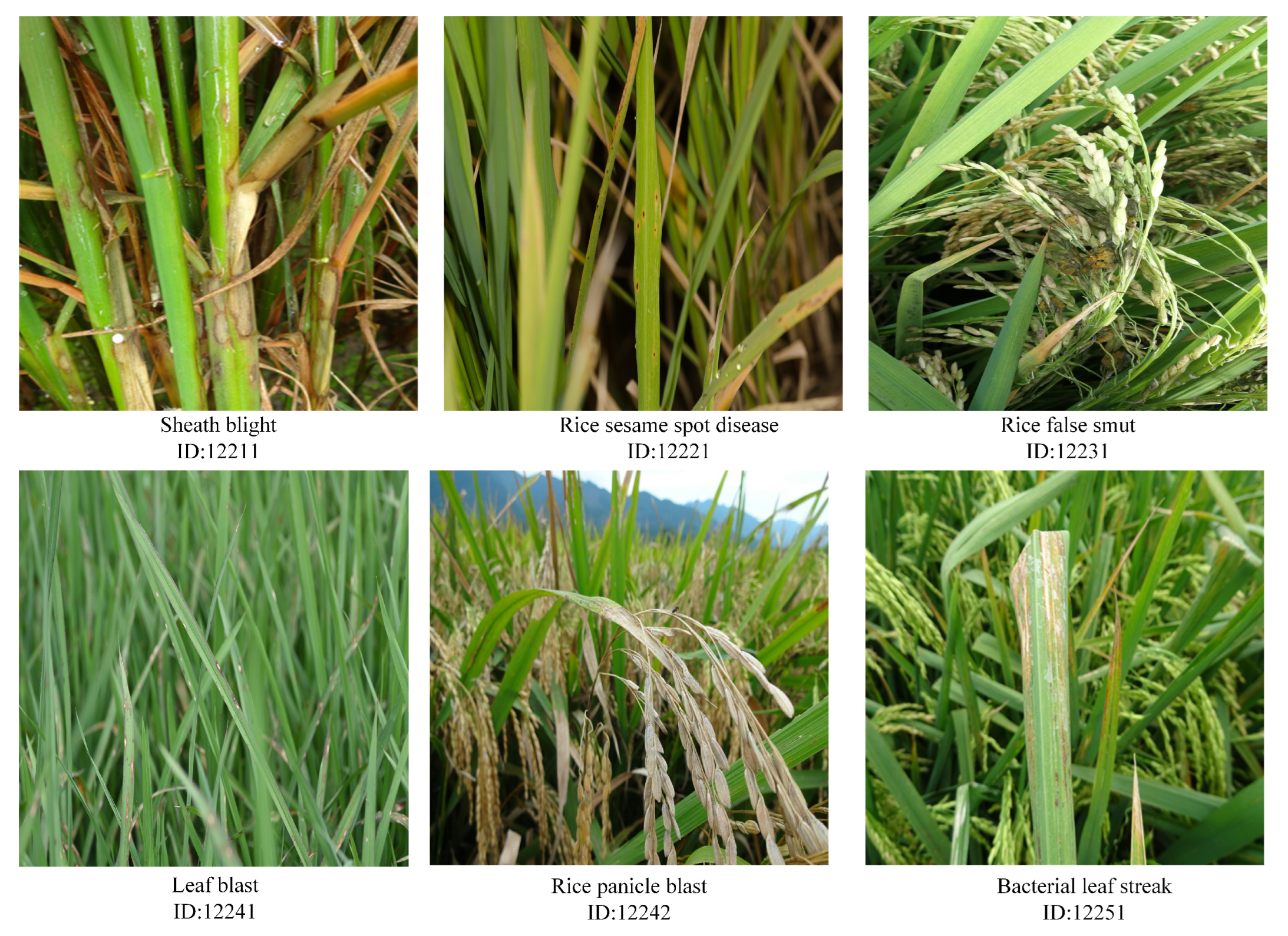


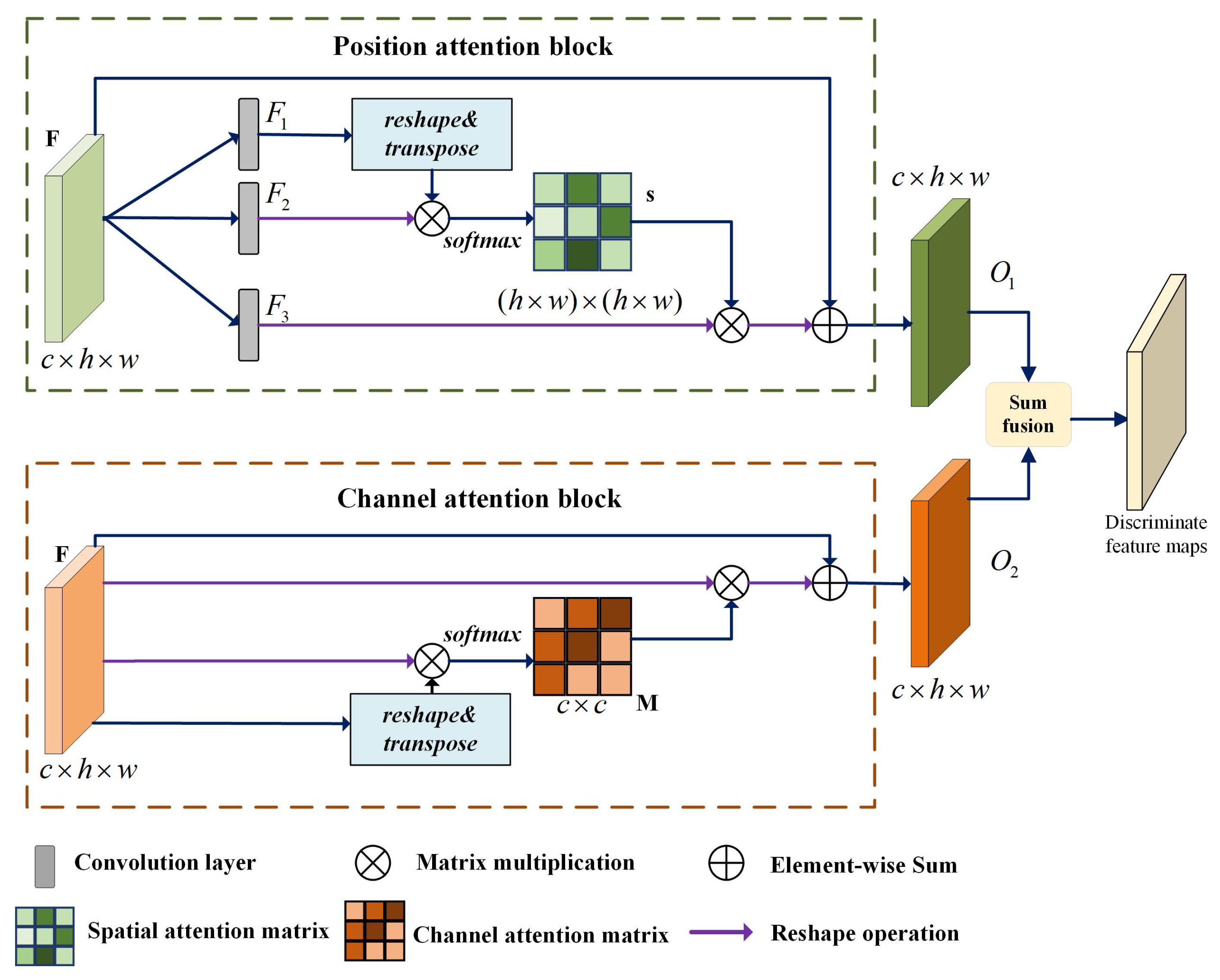
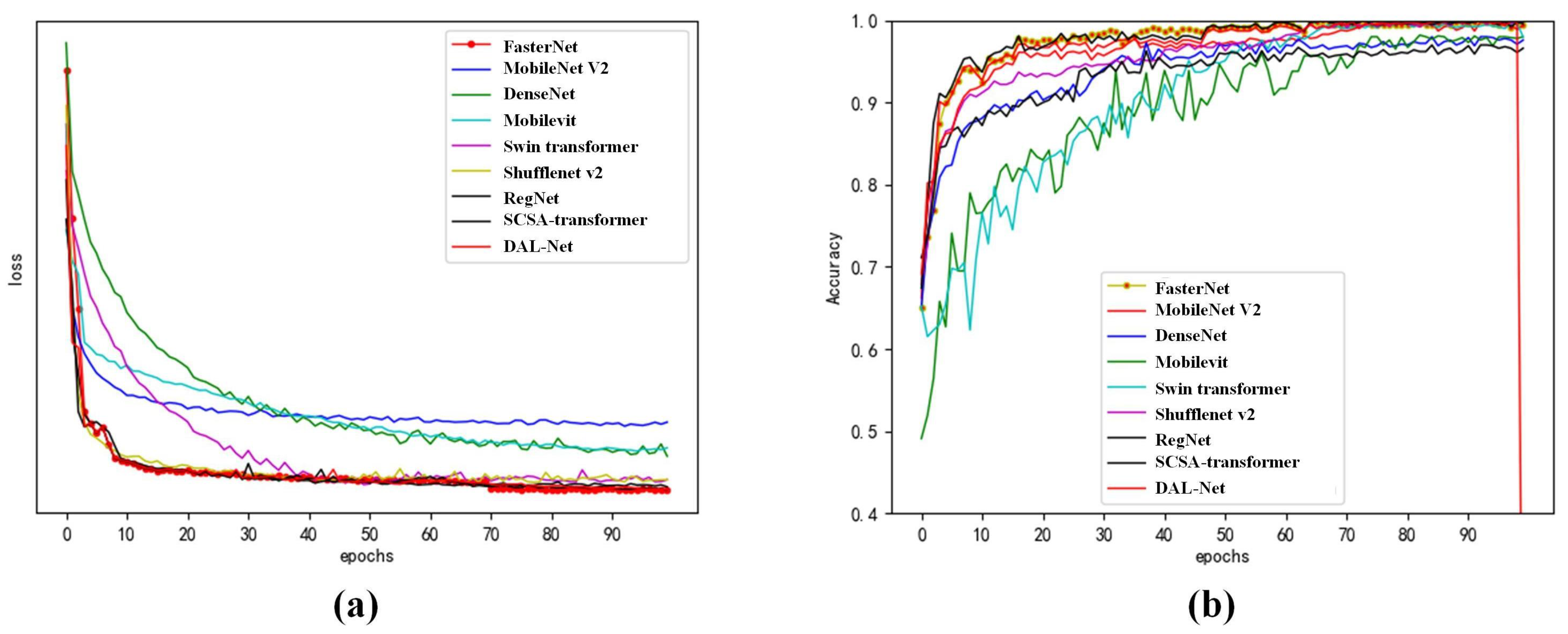
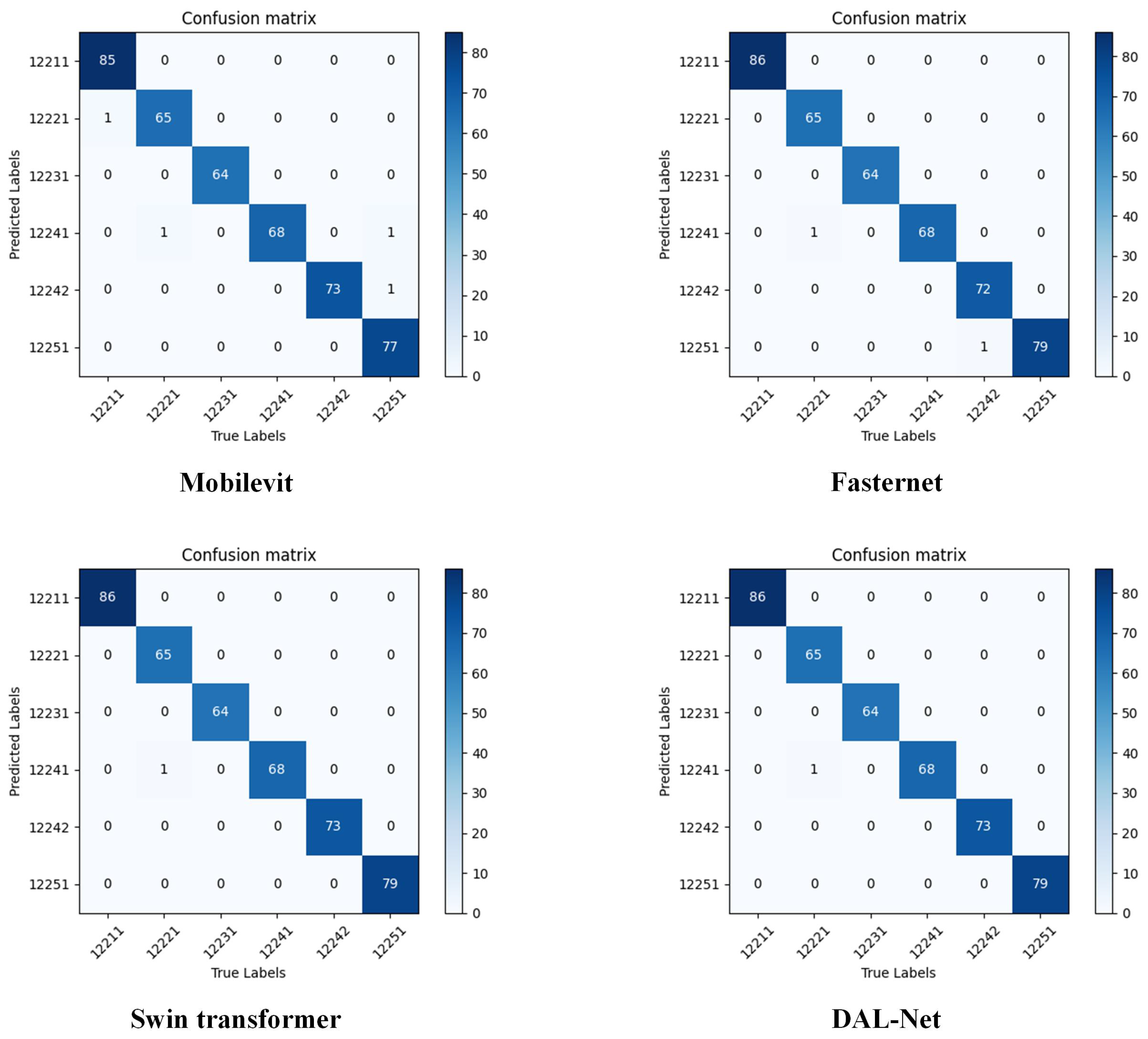
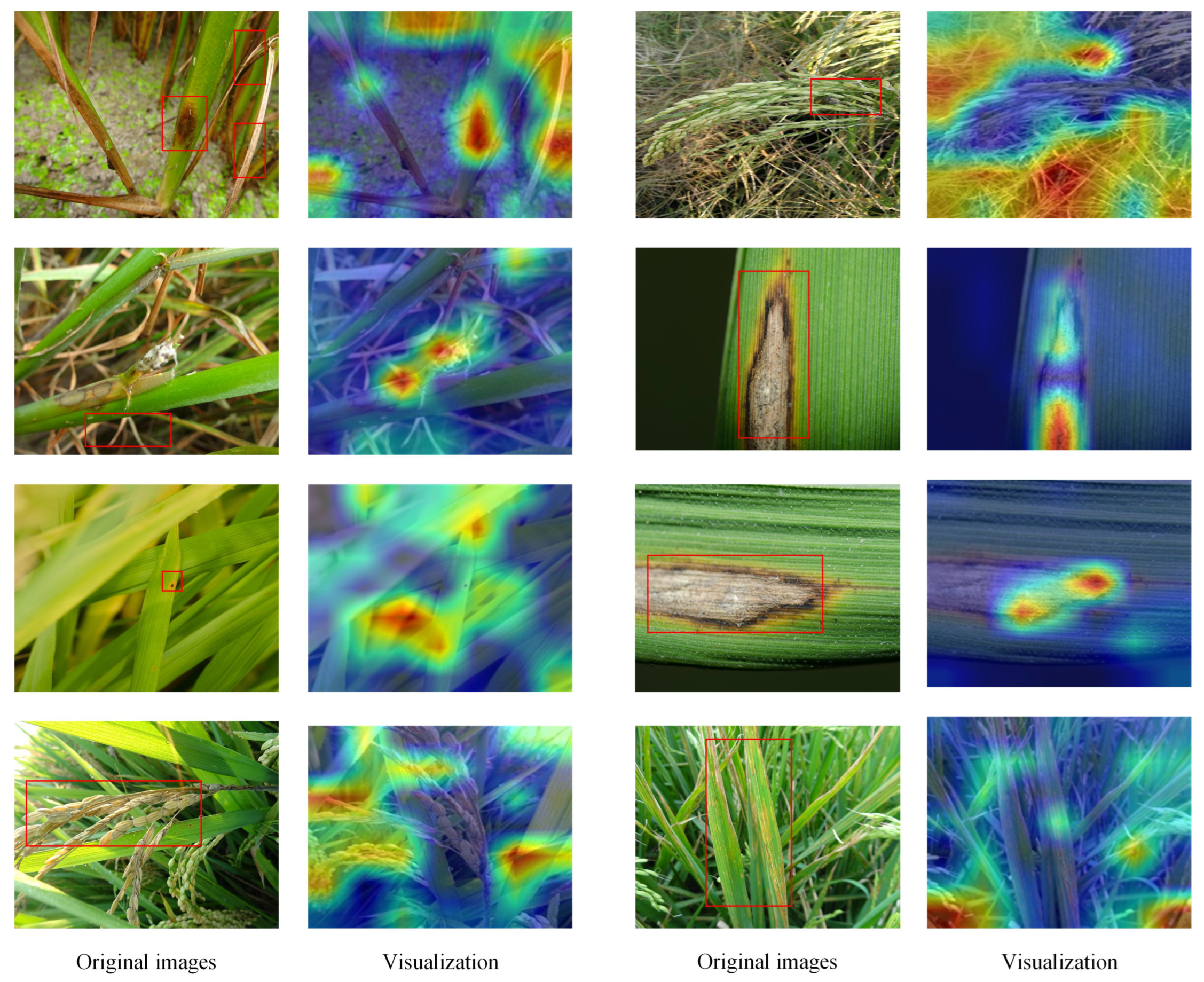
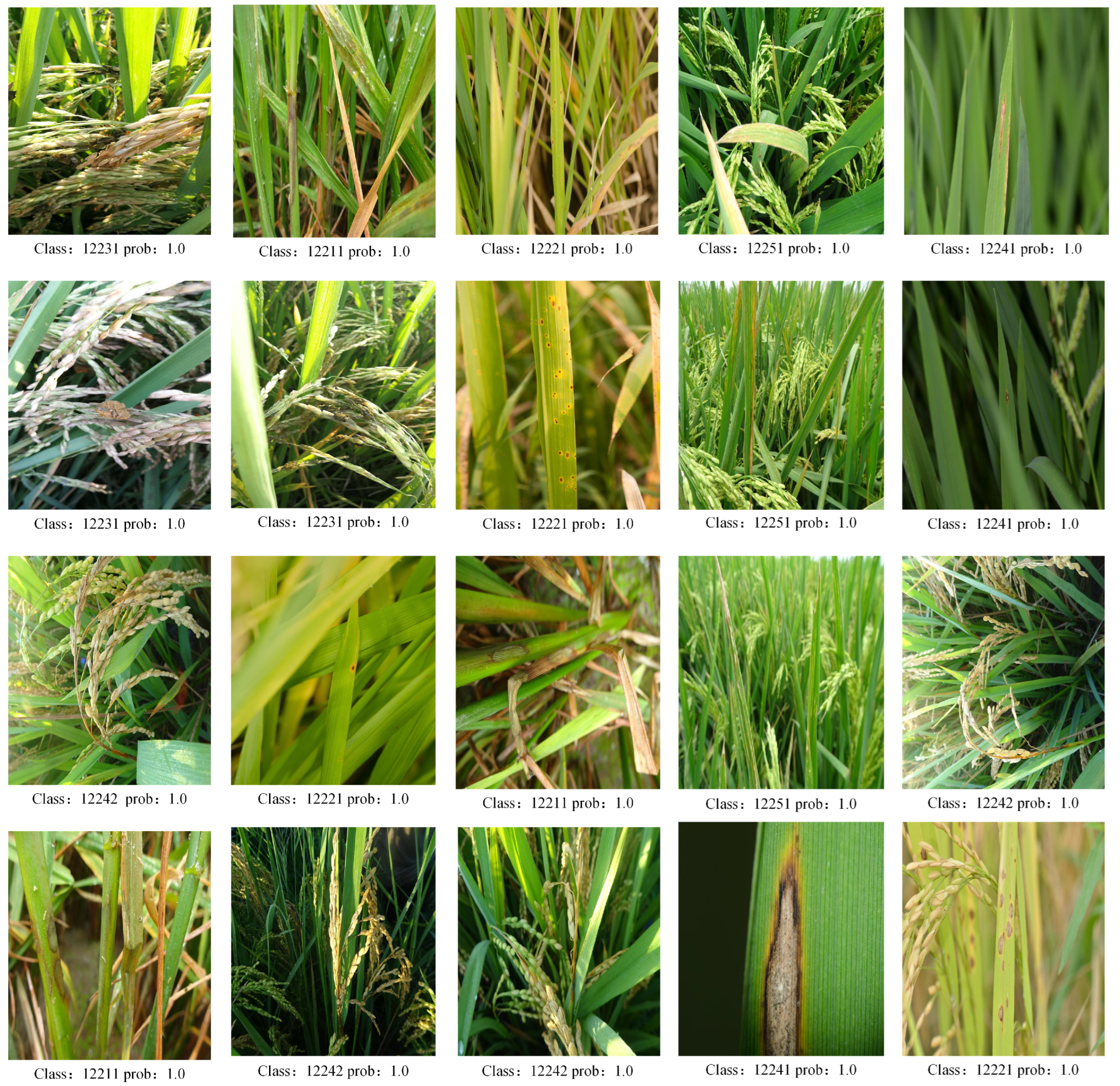
| Category | ID | Number of Samples | Training Set | Testing Set |
|---|---|---|---|---|
| Rice sheath blight | 12211 | 432 | 346 | 86 |
| Rice sesame-spot disease | 12221 | 333 | 267 | 66 |
| Rice false smut | 12231 | 324 | 260 | 64 |
| Rice leaf blast | 12241 | 342 | 274 | 68 |
| Rice panicle blast | 12242 | 369 | 296 | 73 |
| Bacterial leaf streak | 12251 | 396 | 317 | 79 |
| Total number | 2196 | 1760 | 436 |
| Methods | Accuracy (%) | Recall (%) | Precision (%) | Specificity (%) | F1-Score (%) | Parameters (M) |
|---|---|---|---|---|---|---|
| Regnet | 97.85 | 96.33 | 96.44 | 98.54 | 96.38 | 15.7 |
| Densenet | 98.67 | 96.55 | 96.74 | 98.89 | 96.64 | 15 |
| Mobilenet v2 | 99.7 | 99.8 | 99.4 | 99.9 | 99.60 | 15.4 |
| Shufflnet v2 | 99.8 | 100 | 99.9 | 99.7 | 99.96 | 15.6 |
| MobileVit | 99.6 | 99.7 | 99.5 | 99.8 | 99.90 | 5.6 |
| Swin transformer | 99.9 | 100 | 100 | 100 | 100 | 40 |
| SCSA-transformer | 99.9 | 100 | 100 | 100 | 100 | 24.2 |
| DAL-Net | 99.9 | 99.8 | 100 | 100 | 99.9 | 3.6 |
| Category | Accuracy (%) | Recall (%) | Precision (%) | Specificity (%) | F1-Score |
|---|---|---|---|---|---|
| Sheath blight | 100 | 100 | 100 | 100 | 100 |
| Sesame spot disease | 100 | 99.6 | 99.8 | 100 | 99.7 |
| Rice false smut | 99.6 | 100 | 100 | 100 | 100 |
| Leaf blast | 99.8 | 100 | 100 | 99.7 | 100 |
| Rice panicle blast | 100 | 100 | 100 | 100 | 100 |
| Bacterial leaf streak | 100 | 100 | 100 | 100 | 100 |
| Average | 99.90 | 99.93 | 99.97 | 99.95 | 99.95 |
| Method | Position Attention | Channel Attention | Accuracy (%) | Recall (%) | Precision (%) | Specificity (%) | F1-Score (%) | Parameters (M) |
|---|---|---|---|---|---|---|---|---|
| FasterNet | 98.8 | 99 | 98.9 | 99.0 | 98.9 | 3.58 | ||
| √ | 99.5 | 99.3 | 99.4 | 99.5 | 99.1 | 3.59 | ||
| √ | √ | 99.9 | 99.8 | 100 | 100 | 99.9 | 3.6 |
Disclaimer/Publisher’s Note: The statements, opinions and data contained in all publications are solely those of the individual author(s) and contributor(s) and not of MDPI and/or the editor(s). MDPI and/or the editor(s) disclaim responsibility for any injury to people or property resulting from any ideas, methods, instructions or products referred to in the content. |
© 2025 by the authors. Licensee MDPI, Basel, Switzerland. This article is an open access article distributed under the terms and conditions of the Creative Commons Attribution (CC BY) license (https://creativecommons.org/licenses/by/4.0/).
Share and Cite
Kang, C.; Jiao, L.; Liu, K.; Liu, Z.; Wang, R. Fast Rice Plant Disease Recognition Based on Dual-Attention-Guided Lightweight Network. Agriculture 2025, 15, 1724. https://doi.org/10.3390/agriculture15161724
Kang C, Jiao L, Liu K, Liu Z, Wang R. Fast Rice Plant Disease Recognition Based on Dual-Attention-Guided Lightweight Network. Agriculture. 2025; 15(16):1724. https://doi.org/10.3390/agriculture15161724
Chicago/Turabian StyleKang, Chenrui, Lin Jiao, Kang Liu, Zhigui Liu, and Rujing Wang. 2025. "Fast Rice Plant Disease Recognition Based on Dual-Attention-Guided Lightweight Network" Agriculture 15, no. 16: 1724. https://doi.org/10.3390/agriculture15161724
APA StyleKang, C., Jiao, L., Liu, K., Liu, Z., & Wang, R. (2025). Fast Rice Plant Disease Recognition Based on Dual-Attention-Guided Lightweight Network. Agriculture, 15(16), 1724. https://doi.org/10.3390/agriculture15161724






